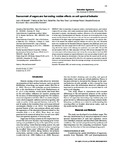Por favor, use este identificador para citar o enlazar este ítem:
http://www.alice.cnptia.embrapa.br/alice/handle/doc/1055007Registro completo de metadatos
| Campo DC | Valor | Lengua/Idioma |
|---|---|---|
| dc.contributor.author | DEMATTÊ, J. A. M. | pt_BR |
| dc.contributor.author | TERRA, F. da S. | pt_BR |
| dc.contributor.author | OTTO, R. | pt_BR |
| dc.contributor.author | TOMA, R. S. | pt_BR |
| dc.contributor.author | PEREIRA, L. H. | pt_BR |
| dc.contributor.author | NASCIMENTO, A. F. do | pt_BR |
| dc.contributor.author | BORTOLETTO, M. A. M. | pt_BR |
| dc.date.accessioned | 2016-10-19T11:11:11Z | pt_BR |
| dc.date.available | 2016-10-19T11:11:11Z | pt_BR |
| dc.date.created | 2016-10-19 | pt_BR |
| dc.date.issued | 2016 | pt_BR |
| dc.identifier.citation | Scientia Agricola, Piracicaba, v. 73, n. 2, p. 159-168, mar./abr., 2016 | pt_BR |
| dc.identifier.issn | 0103-9016 | pt_BR |
| dc.identifier.uri | http://www.alice.cnptia.embrapa.br/alice/handle/doc/1055007 | pt_BR |
| dc.description | When the harvesting of sugarcane involves a mechanized process, plant residues remain on the soil surface, which makes proximal and remote sensing difficult to monitor. This study aimed to evaluate, under laboratory conditions, differences in the soil spectral behavior of surface layers Quartzipsamment and Hapludox soil classes due to increasing levels of sugarcane?s dry (DL) and green (GL) leaf cover on the soil. Soil cover was quantified by supervised classification of the digital images (photography) taken of the treatments. The spectral reflectance of the samples was obtained using the FieldSpec Pro (350 to 2500 nm). TM-Landsat bands were simulated and the Normalized Difference Vegetation Index (NDVI) and soil line were also determined. Soil cover ranged from 0 to 89 % for DL and 0 to 80 % for GL. Dry leaf covering affected the features of the following soil constituents: iron oxides (480, 530 and 900 nm) and kaolinite (2200 nm). Water absorption (1400 and 1900 nm) and chlorophyll (670 nm) were determinant in differentiating between bare soil and GL covering. Bands 3 and 4 and NDVI showed pronounced variations as regards differences in soil cover percentage for both DL and GL. The soil line allowed for discrimination of the bare soil from the covered soil (DL and GL). High resolution sensors from about 50 % of the DL or GL covering are expected to reveal differences in soil spectral behavior. Above this coverage percentage, soil assessment by remote sensing is impaired. | pt_BR |
| dc.language.iso | por | pt_BR |
| dc.rights | openAccess | pt_BR |
| dc.subject | TM-Landsat | pt_BR |
| dc.subject | NDVI | pt_BR |
| dc.subject | Soil remote sensing | pt_BR |
| dc.subject | Soil proximal sensing | pt_BR |
| dc.subject | Soil line | pt_BR |
| dc.title | Assessment of sugarcane harvesting residue effects on soil spectral behavior. | pt_BR |
| dc.type | Artigo de periódico | pt_BR |
| dc.date.updated | 2016-10-19T11:11:11Z | pt_BR |
| riaa.ainfo.id | 1055007 | pt_BR |
| riaa.ainfo.lastupdate | 2016-10-19 | pt_BR |
| dc.identifier.doi | http://dx.doi.org/10.1590/0103-9016-2014-0370 | pt_BR |
| dc.contributor.institution | José A. M. Demattê, USP-ESALQ; Fabrício da Silva Terra, UFVJM; Rafael Otto, USP-ESALQ; Raul Shiso Toma, UFC; Luiz Henrique Pereira, UNESP-IGCE; ALEXANDRE FERREIRA DO NASCIMENTO, CPAMT; Marco Antonio Melo Bortoletto, GRUPO CLEALCO. | pt_BR |
| Aparece en las colecciones: | Artigo em periódico indexado (CPAMT)  | |
Ficheros en este ítem:
| Fichero | Descripción | Tamaño | Formato | |
|---|---|---|---|---|
| 2016cpamtnascimentosurganeresidueeffectssoil.pdf | 1,15 MB | Adobe PDF |  Visualizar/Abrir |









